

Endeligt.pdf. Firenze Romana - FLORENCE LIVE! Prior to the founding of this Roman colony, the area had been inhabited by communities of Ligurians in the Neolithic Period, followed by groups known simply as "Italian Peoples" (c.10th century B.C.) who originated in the mountains of Tuscany and Emilia, and then beginning in the 8th century B.C., by the Etruscans.
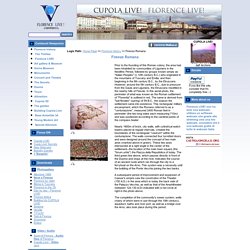
However, around the 5th century B.C., due to pressure from the Gauls and Ligurians, the Etruscans resettled in the nearby hills of Fiesole. In this aerial photo, the perimeter of what was known as the Roman settlement of "Florentia" is outlined in red. The name is derived from "ludi florales" (spring) of 59 B.C., the season the settlement came into existence. This rectangular military encampment, which the Romans referred to as a "centuriazione", measured 2400 Roman feet in perimeter (the two long sides each measuring 710m) and was positioned according to the cardinal points of the compass.heater. Roman Heritage in Algeria- Breath Taking Images of Timgad.
Timgad (called Thamugas or Tamugadi in old Berber) was a Roman colonial town in the Aurès Mountains of Algeria, founded by the Emperor Trajan around AD 100.
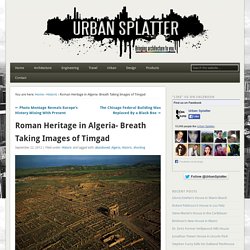
The full name of the town was Colonia Marciana Ulpia Traiana Thamugadi. Trajan commemorated the city after his mother Marcia, father Marcus Ulpius Traianus and his eldest sister Ulpia Marciana. Located in modern-day Algeria, about 35 km east of the town of Batna, the ruins are noteworthy for representing one of the best extant examples of the grid plan as used in Roman city planning. Arkitekturhistoriske noter, den romerske arkitektur. Roman Architecture Facts - Ancient Rome for Kids. Ancient Roman Architecture Like art and other aspects of Ancient Roman culture, early Roman architecture borrowed heavily from Greek architecture.

However, the Romans quickly adapted their own styles and were soon inspiring the architecture of many other countries. A beginner's guide to ancient Rome. Roman Architecture - Ancient Rome for Kids! Digging History 7: The Architecture and Engineering of Rome. Ostia Antica Chapter 7: Roman Construction. Roman Engineering and Architecture - Video & Lesson Transcript. Roman roads. Roman roads (in Latin, viae - singular via) were vital to the maintenance and development of the Roman state, and were built from about 500 BC through the expansion and consolidation of the Roman Republic and the Roman Empire.[1] They provided efficient means for the overland movement of armies, officials and civilians, and the inland carriage of official communications and trade goods.[2] Roman roads were of several kinds, ranging from small local roads to broad, long-distance highways built to connect cities, major towns and military bases.
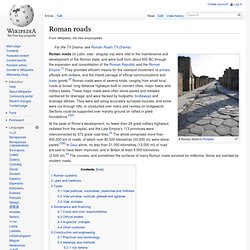
These major roads were often stone-paved and metaled, cambered for drainage, and were flanked by footpaths, bridleways and drainage ditches. They were laid along accurately surveyed courses, and some were cut through hills, or conducted over rivers and ravines on bridgework. Sections could be supported over marshy ground on rafted or piled foundations.[3][4] Roman Roads and Bridges. Romans in Britain - Roman Building Techniques. The Romans had a great liking for arches and made use of them in as many different buildings as possible.
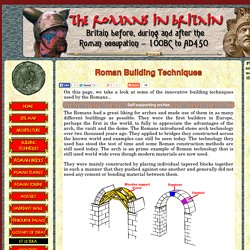
They were the first builders in Europe, perhaps the first in the world, to fully to appreciate the advantages of the arch, the vault and the dome. The Romans introduced stone arch technology over two thousand years ago. They applied to bridges they constructed across the known world and examples can still be seen today. The technology they used has stood the test of time and some Roman construction methods are still used today. The arch is an prime example of Roman technology that is still used world wide even though modern materials are now used. Roman engineering. Romans are famous for their advanced engineering accomplishments, although some of their own inventions were improvements on older ideas, concepts and inventions.
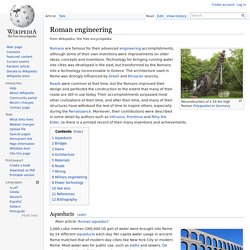
Technology for bringing running water into cities was developed in the east, but transformed by the Romans into a technology inconceivable in Greece. The architecture used in Rome was strongly influenced by Greek and Etruscan sources. Roads were common at that time, but the Romans improved their design and perfected the construction to the extent that many of their roads are still in use today. Their accomplishments surpassed most other civilizations of their time, and after their time, and many of their structures have withstood the test of time to inspire others, especially during the Renaissance.
Construction Techniques in Ancient Rome. Roman Architecture. Roman architecture continued the legacy left by the earlier architects of the Greek world, and the Roman respect for this tradition and their particular reverence for the established architectural orders, especially the Corinthian, is evident in many of their large public buildings.
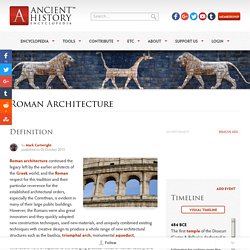
However, the Romans were also great innovators and they quickly adopted new construction techniques, used new materials, and uniquely combined existing techniques with creative design to produce a whole range of new architectural structures such as the basilica, triumphal arch, monumental aqueduct, amphitheatre, granary building, and residential housing block.
Many of these innovations were a response to the changing practical needs of Roman society, and these projects were all backed by a state apparatus which funded, organised, and spread them around the Roman world, guaranteeing their permanence so that many of these great edifices survive to the present day. Typical Roman Stone Arch Construction.